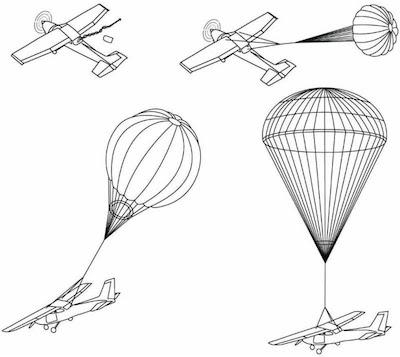First In-Field Deployment of SF50 Ballistic Parachute System
The aircraft ballistic parachute (Ballistic Recovery System/BRS) is a controversial contraption.

Non-aerospace types—the citizens who can’t tell an MD-80 from a 747 and gasp disbelievingly at the notion that Cessna makes jets—look admiringly upon the notion of a panacean fix for every conceivable instance of derelict engineering, mechanical failure, or pilot incompetence. Pitot icing? Deploy the parachute. Vacuum failure? Deploy the parachute. Sticky push-to-talk button? Deploy the parachute.
Salty pilots and inveterate aircraft designers look skeptically upon the ballistic parachute, however, and offer compelling arguments against its proliferation throughout the light aircraft industry. An airplane under canopy is utterly uncontrollable, for instance, and apt to descend into all manner of trouble. In many instances, gliding a fixed-wing aircraft to a semi-controlled crash landing is preferable to drifting down into a nuclear reactor’s cooling tower or the path of an oncoming train.
Certainly, in rare instances of the catastrophic airframe or engine failure, a ballistic recovery system is apt to prove advantageous—just as mounting a howitzer on a Honda Accord might prove advantageous during a jag of road-rage.
Regardless of which side of the BRS fence one occupies, the 09 September crash of a Cirrus SF50 Vision jet is apt to be of interest—if not probative value.
The incident occurred around 15:15 EDT while N77VJ was on approach to Florida’s Kissimmee Gateway Airport. Details are vague, but a preliminary FAA report states the aircraft encountered severe turbulence resultant of local thunderstorms. For reasons unknown, the pilot deployed the aircraft’s BRS—which Cirrus ostentatiously markets as the Cirrus Airframe Parachute System (CAPS)—thereby initiating a descent that brought the airplane down into a marshy wooded area near the eastern shore of Lake Toho.
The aircraft’s three passengers—an adult male and female and a minor male—were transported to a nearby hospital. The woman was reported to have sustained serious but non-life-threatening injuries. The condition of the male passengers was categorized as fair.

Osceola County Fire Rescue EMS spokesman Andrew Sullivan remarked: "It was very difficult for crews to get to it [the downed aircraft]. We had to take chainsaws to get back to it. The area is enclosed by barbed wire, so neighbors in the area were very helpful, letting us through their property to get to the crash site."
Following the Kissimmee incident, a Cirrus company spokesperson asserted: “This is the first deployment of the CAPS on a fielded Vision Jet aircraft. We are grateful to learn of the reported outcome of the incident and our thoughts are with those involved for a quick recovery.” The spokesperson capitalized on the opportunity to point out that Cirrus’s CAPS has “returned over 230 people home safely to date” but declined to provide details about the deployments to which he alluded. Since Cirrus has a poor record of being honest with the media (based on our experience), we advise caution in taking any of their statements at face value.
 ANN's Daily Aero-Term (12.04.25): Cooperative Surveillance
ANN's Daily Aero-Term (12.04.25): Cooperative Surveillance ANN's Daily Aero-Linx (12.04.25)
ANN's Daily Aero-Linx (12.04.25) NTSB Prelim: Extra Flugzeugproduktions EA 300/SC
NTSB Prelim: Extra Flugzeugproduktions EA 300/SC Classic Aero-TV: The Bally Bomber - The All Time Ultimate Warbird Replica?
Classic Aero-TV: The Bally Bomber - The All Time Ultimate Warbird Replica? ANN's Daily Aero-Linx (12.05.25)
ANN's Daily Aero-Linx (12.05.25)




